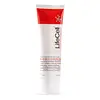What's inside
What's inside
 Key Ingredients
Key Ingredients

 Benefits
Benefits

 Concerns
Concerns

 Ingredients Side-by-side
Ingredients Side-by-side

Water
Skin ConditioningHexylene Glycol
EmulsifyingGlycerin
HumectantIsohexadecane
EmollientPolysorbate 20
EmulsifyingDimethyl Mea
BufferingThioctic Acid
AntioxidantTetrahexyldecyl Ascorbate
AntioxidantPalmitoyl Tripeptide-5
Skin ConditioningAcetyl Tyrosine
Skin ConditioningLepidium Sativum Sprout Extract
Skin ConditioningOlea Europaea Leaf Extract
PerfumingMagnesium Ascorbyl Phosphate
AntioxidantTetrahydrodemethoxydiferuloylmethane
AntioxidantEpigallocatechin Gallatyl Glucoside
AntioxidantTocopheryl Acetate
AntioxidantTetrahydrodiferuloylmethane
AntioxidantTetrahydrobisdemethoxydiferuloylmethane
AntioxidantLecithin
EmollientCarbomer
Emulsion StabilisingDisodium EDTA
Sorbitol
HumectantCaprylyl Glycol
EmollientPhenoxyethanol
PreservativeParfum
MaskingAmyl Cinnamal
PerfumingHydroxycitronellal
PerfumingLinalool
PerfumingWater, Hexylene Glycol, Glycerin, Isohexadecane, Polysorbate 20, Dimethyl Mea, Thioctic Acid, Tetrahexyldecyl Ascorbate, Palmitoyl Tripeptide-5, Acetyl Tyrosine, Lepidium Sativum Sprout Extract, Olea Europaea Leaf Extract, Magnesium Ascorbyl Phosphate, Tetrahydrodemethoxydiferuloylmethane, Epigallocatechin Gallatyl Glucoside, Tocopheryl Acetate, Tetrahydrodiferuloylmethane, Tetrahydrobisdemethoxydiferuloylmethane, Lecithin, Carbomer, Disodium EDTA, Sorbitol, Caprylyl Glycol, Phenoxyethanol, Parfum, Amyl Cinnamal, Hydroxycitronellal, Linalool
Water
Skin ConditioningC12-15 Alkyl Benzoate
AntimicrobialAvena Sativa Kernel Extract
AbrasivePersea Gratissima Fruit Butter
EmollientButyrospermum Parkii Butter
Skin ConditioningCetearyl Alcohol
EmollientSilicon
AbrasiveTitanium Dioxide
Cosmetic ColorantGlycerin
HumectantDiethyl Ethanolamine
BufferingCetearyl Glucoside
EmulsifyingSclerotium Gum
Emulsion StabilisingIron Oxides
Thioctic Acid
AntioxidantTetrahydrobisdemethoxydiferuloylmethane
AntioxidantSpilanthes Acmella Flower Extract
Skin ConditioningRetinol
Skin ConditioningMalus Domestica Fruit Cell Culture Extract
Skin ConditioningMagnesium Ascorbyl Phosphate
AntioxidantGlycine Soja Oil
EmollientMagnesium Carbonate Hydroxide
BufferingCaprylic/Capric Triglyceride
MaskingHydroxyethyl Acrylate/Sodium Acryloyldimethyl Taurate Copolymer
Emulsion StabilisingPhenoxyethanol
PreservativeTribehenin
EmollientAcrylamide/Sodium Acryloyldimethyltaurate Copolymer
Emulsion StabilisingCeramide Ns
Skin ConditioningEthylhexylglycerin
Skin ConditioningPalmitoyl Oligopeptide
CleansingPalmitoyl Tetrapeptide-7
Skin ConditioningRetinyl Palmitate
Skin ConditioningPEG-10 Rapeseed Sterol
CleansingHesperidin Methyl Chalcone
AntioxidantSteareth-20
CleansingPalmitoyl Tripeptide-5
Skin ConditioningAcetyl Hexapeptide-8
HumectantDipeptide-2
Skin ConditioningCholecalciferol
Ubiquinone
AntioxidantTocopherol
AntioxidantTocopheryl Acetate
AntioxidantSodium Hyaluronate
HumectantZea Mays Oil
EmulsifyingAscorbyl Palmitate
AntioxidantWater, C12-15 Alkyl Benzoate, Avena Sativa Kernel Extract, Persea Gratissima Fruit Butter, Butyrospermum Parkii Butter, Cetearyl Alcohol, Silicon, Titanium Dioxide, Glycerin, Diethyl Ethanolamine, Cetearyl Glucoside, Sclerotium Gum, Iron Oxides, Thioctic Acid, Tetrahydrobisdemethoxydiferuloylmethane, Spilanthes Acmella Flower Extract, Retinol, Malus Domestica Fruit Cell Culture Extract, Magnesium Ascorbyl Phosphate, Glycine Soja Oil, Magnesium Carbonate Hydroxide, Caprylic/Capric Triglyceride, Hydroxyethyl Acrylate/Sodium Acryloyldimethyl Taurate Copolymer, Phenoxyethanol, Tribehenin, Acrylamide/Sodium Acryloyldimethyltaurate Copolymer, Ceramide Ns, Ethylhexylglycerin, Palmitoyl Oligopeptide, Palmitoyl Tetrapeptide-7, Retinyl Palmitate, PEG-10 Rapeseed Sterol, Hesperidin Methyl Chalcone, Steareth-20, Palmitoyl Tripeptide-5, Acetyl Hexapeptide-8, Dipeptide-2, Cholecalciferol, Ubiquinone, Tocopherol, Tocopheryl Acetate, Sodium Hyaluronate, Zea Mays Oil, Ascorbyl Palmitate
Alternatives
Ingredients Explained
These ingredients are found in both products.
Ingredients higher up in an ingredient list are typically present in a larger amount.
Glycerin is already naturally found in your skin. It helps moisturize and protect your skin.
A study from 2016 found glycerin to be more effective as a humectant than AHAs and hyaluronic acid.
As a humectant, it helps the skin stay hydrated by pulling moisture to your skin. The low molecular weight of glycerin allows it to pull moisture into the deeper layers of your skin.
Hydrated skin improves your skin barrier; Your skin barrier helps protect against irritants and bacteria.
Glycerin has also been found to have antimicrobial and antiviral properties. Due to these properties, glycerin is often used in wound and burn treatments.
In cosmetics, glycerin is usually derived from plants such as soybean or palm. However, it can also be sourced from animals, such as tallow or animal fat.
This ingredient is organic, colorless, odorless, and non-toxic.
Glycerin is the name for this ingredient in American English. British English uses Glycerol/Glycerine.
Learn more about GlycerinMagnesium Ascorbyl Phosphate (MAP) is a form of Vitamin C and is an antioxidant. It can help to reduce redness, improve skin texture, reduce the effects of aging, reduce the visibility of dark spots, and brighten skin.
MAP is created by combining ascorbic acid with magnesium salt. While MAP more gentle on the skin than ascorbic acid, it is thought to be less easily-absorbed into the skin.
Due to MAP's stability up to a pH level of 7, it is more stable to air and sunlight exposure than ascorbic acid. The best pH range for MAP is between 5 and 6.
Like other forms of Vitamin C, MAP has been shown to help reduce hyperpigmentation and simulate collagen production.
As an antioxidant, it helps protect your skin against the signs of aging.
Learn more about Magnesium Ascorbyl PhosphateThis synthetic peptide is created from lysine, valine, and palmitic acid.
According to the manufacturer, in-vitro studies show tissue growth and collagen synthesis. Another in-vivo study found 60 volunteers saw a significant reduction in wrinkles after 84 days.
Due to its palmitic acid base, this peptide may not be fungal-acne safe.
Learn more about Palmitoyl Tripeptide-5Phenoxyethanol is a preservative that has germicide, antimicrobial, and aromatic properties. Studies show that phenoxyethanol can prevent microbial growth. By itself, it has a scent that is similar to that of a rose.
It's often used in formulations along with Caprylyl Glycol to preserve the shelf life of products.
Tetrahydrobisdemethoxydiferuloylmethane is an antioxidant.
Thioctic Acid is an enzyme and antioxidant. A more common name for this is Alpha Lipoic Acid.
Alpha Lipoic Acid can be naturally found in the mitochondria of every cell.
Antioxidants help fight free-radicals. Free-radicals are molecules that may damage your skin cells. The antioxidants in Alpha Lipoic Acid have been shown to fight damage from cigarette smoke.
Studies also show Alpha Lipoic Acid plays a role in wound healing.
Thioctic Acid will break down when exposed to sunlight.
Many foods contain thioctic acid, including tomato, brussel sprouts, spinach, and broccoli.
Learn more about Thioctic AcidTocopheryl Acetate is AKA Vitamin E. It is an antioxidant and protects your skin from free radicals. Free radicals damage the skin by breaking down collagen.
One study found using Tocopheryl Acetate with Vitamin C decreased the number of sunburned cells.
Tocopheryl Acetate is commonly found in both skincare and dietary supplements.
Learn more about Tocopheryl AcetateWater. It's the most common cosmetic ingredient of all. You'll usually see it at the top of ingredient lists, meaning that it makes up the largest part of the product.
So why is it so popular? Water most often acts as a solvent - this means that it helps dissolve other ingredients into the formulation.
You'll also recognize water as that liquid we all need to stay alive. If you see this, drink a glass of water. Stay hydrated!
Learn more about Water